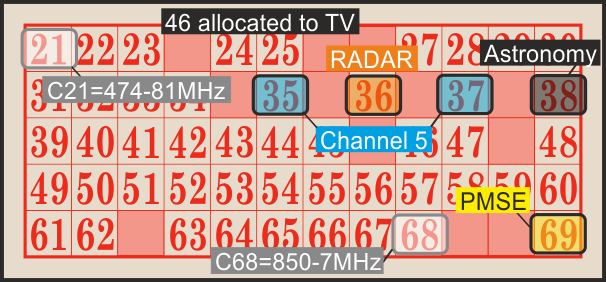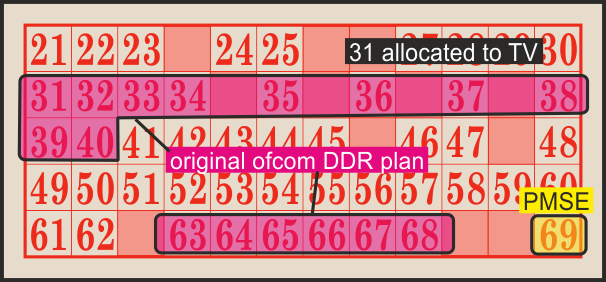Freeview 2020 vs 4G mobile - play Ofcom channel bingo
 Brian Butterworth published on UK Free TV
Brian Butterworth published on UK Free TV Since the launch of "625 line" UHF television, broadcast television services in the UK have used a range of frequencies running from 474MHz to 867MHz, each in blocks of 8MHz.
To make the allocations easier to understand, they have been allocated "channel numbers" starting at C21 and ranging up to C69.
For around four decades the official allocations provided these channel numbers to the BBC, the ITV companies, then Channel 4 (or S4C in Wales) and eventually Channel 5 to provide analogue television services. The following "bingo card" shows the allocations are they were from the 1960s to the millennium.

As you can see, C36 was used for RADAR, C38 for radio astronomy, and C69 was used for "programme making and special events" (PMSE), which generally means the low-power radio equipment used at outside broadcasts.
In the late 1990s, low-power terrestrial digital television launched (as ONdigital, then ITV Digital), these services were squeezed into the existing plan in the UK.
When Freeview became a consumer success, it was decided that the analogue services would be switched off and replaced with just high-powered digital services. As part of this there would be a "digital dividend review" because the digital-only plan would free up some of the TV frequencies, as digital channels can co-exist more efficiently than the outdated analogue TV could. The plan looked like this:

However, it became clear during early 2009 that the 790-862 MHz frequencies would be co-ordinated over the whole of Europe for fourth-generation mobile broadband (Digital Dividend - changes to the 800MHz ). These new mobile broadband services are referred to as "4G" and "Long Term Evolution" (LTE). This left the plan as we find it today:

One of the effects is that some transmitters in switched-over regions are moving services from C61 and C62 into next year - 2013 - post-switchover changes to Freeview transmission frequencies.
What does the future hold? Part two: Ofcom channel bingo II - introducing the bands
1:30 PM
Dave Lindsay: I don't know whether the 800Mhz band was sought because it goes through walls better, or whether it was a case of additional frequencies being required to accommodate the growing use of mobile broadband and the bonus of improved propagation on the soon to be available spectrum became an important factor in making the provision more cost effective for rural areas. It was becoming increasingly obvious that government targets for broadband provision could not be met economically with BT fibre optic cables, so 4G is now the flavour of the year!
| link to this comment |